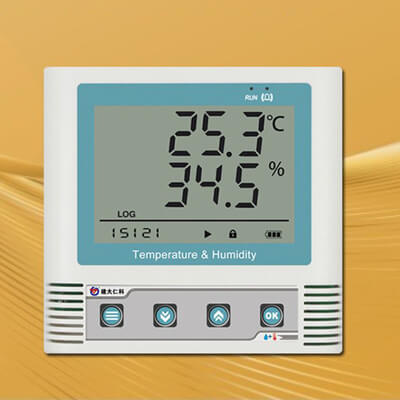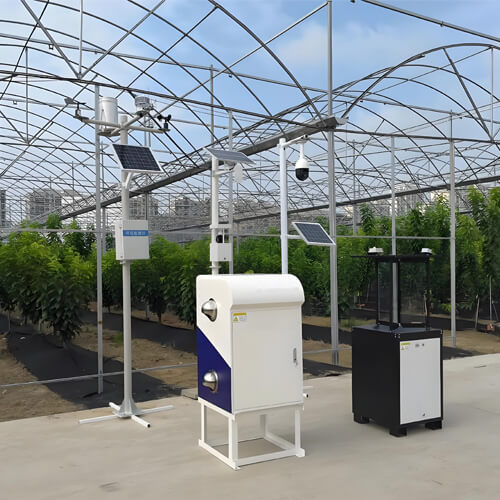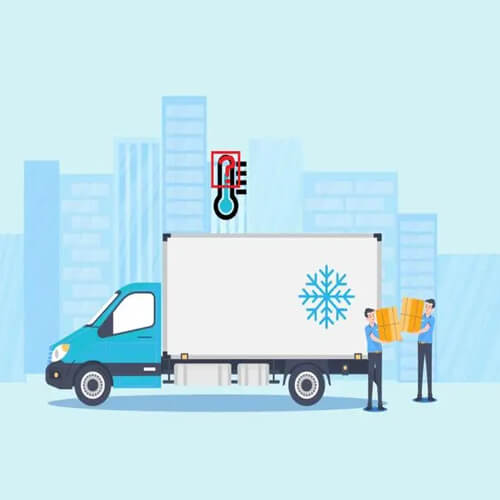Temperature and humidity data loggers are widely used in various industries across the country, such as agricultural research, food safety, pharmaceutical storage, chemical industry, environmental protection and other industries. The temperature and humidity data logger, also called the temperature and humidity recorder, is mainly used for the monitoring and recording of the temperature and humidity during the storage and transportation of food, medicine, and fresh items. With the increasing level of modern technology, temperature and humidity data logger are becoming more and more important in our lives.
What is a temperature data logger?
A temperature and humidity data logger is a type of temperature and humidity measuring instrument. It has a built-in temperature and humidity sensor or an external temperature and humidity sensor probe. The recorder is mainly used to record the temperature and humidity data of food, medicine, chemicals and other products during storage and transportation, and save the data record in the equipment. Usually, the temperature data logger also has a PC data upload function, which can be used for data viewing and analysis. Through the data platform, curve analysis can be performed, and functions such as TEXT, EXCEL, and PDF can be saved.
What is the function of the temperature and humidity data logger?
- Measurement: Built-in temperature and humidity sensor or can be connected to an external temperature and humidity sensor to measure temperature data
- Record storage: automatically record and store the measured temperature value
- Data transmission function: transmit the retained measurement data to the computer in some way (such as RS232, USB, RS485, GPRS, etc.)
- Analysis function: make a necessary analysis of temperature data through the built-in computer analysis software
Types of temperature and humidity data loggers
Classification by recording medium
1. Paper temperature and humidity data logger
The paper temperature data logger directly records the collected temperature, humidity and other data on the recording paper. Therefore, the paper temperature and humidity data logger needs to use consumables such as recording paper, ink cartridge belt/writing pen, etc. When recording. The paper temperature data logger mainly draws curves on the recording paper through a mechanical recording pen, so as to achieve the purpose of recording and saving data. Data is saved by recording paper.

Compared with the current electronic temperature and humidity data logger, the paper temperature data logger is larger and inconvenient to use. It is necessary to check the recorded data through the recording paper, and only the approximate trend changes can be checked according to the values and curves on the recording paper. Due to the limitation of its mechanical transmission structure, the paper temperature and humidity data logger can only be equipped with fewer functions such as alarm output, and there cannot be too many input channels, so it is rarely sold in the market.
2. Paperless temperature and humidity data logger
Paperless temperature and humidity data logger: adopts microprocessor, display screen and memory. It is the earliest name of all electronic temperature recorders. Save data through memory. The display mode can be digital or graphic, and the display screen can be black and white, blue screen or color. It can also be used without a display screen, such as a button temperature recorder or a disposable U disk temperature recorder.
With the development of computer and Internet technology, the paperless temperature and humidity data logger has quickly occupied the market with its more accurate data recording, more convenient data storage, and more convenient data analysis functions. The paperless temperature and humidity data logger with a USB interface greatly facilitates the downloading and saving of data.
Classification by data transmission
The rs485 temperature and humidity data logger is a device that uploads measurement data to the platform through the standard Modbus protocol. The installation process requires the layout of 485 signal lines. Like the RS232 temperature humidity data logger and the Ethernet temperature humidity data logger, they are all wired temperature and humidity data loggers.
The signal transmission of the Rs485 temperature and humidity data logger is more stable than that of the wireless temperature data logger because it is not affected by the signal transmitter and the external environment. Therefore, it is widely used in some fixed places that require high temperature and humidity data.
The rs485 temperature and humidity data logger is usually widely used in production workshops, laboratories, server rooms, pharmacies, and other fixed places that require 24-hour monitoring.
WiFi temperature and humidity data logger refers to a device that uses WiFi as a signal transmission medium, uploads the collected temperature and humidity data to the network in real time, and can record and store data by itself. Because the equipment uses WiFi as the signal transmission medium, the construction volume is greatly reduced, the construction cost is reduced, and the hidden danger of wiring errors is also avoided.
For example, a clothing manufacturing factory has a total of 12 workshops. At present, all workshops have been fully covered by WIFI. In order to ensure the comfortable environment of the workshops, the temperature and humidity data of each workshop are now collected, and the temperature and humidity data must be sent to the monitoring room. The wifi temperature and humidity data logger is the best choice.

The Wifi temperature and humidity data logger has an LCD display, which can display temperature, humidity, time, and device status in real-time. In the event of a power failure, the device can also record the temperature and humidity conditions through the backup battery, and upload the data to the platform after the power is restored. Users can set the upper and lower limits of temperature and humidity according to their own needs. Once it is higher or lower than the set value, the device will alarm and notify the user by email or text message.
The temperature and humidity data logger of Renke RS-WS-WIFI-6 can be extended with multiple probes to become a multi-channel temperature data logger. One device can install up to four probes, and measure the temperature and humidity in four freezers or incubators at the same time. The probe line is up to 30 meters long. It is undoubtedly an effective cost-saving method for different adjacent places. Wifi temperature and humidity data loggers are widely used in computer rooms, buildings, hotels, libraries, archives and other occasions that require temperature and humidity monitoring.
When transporting frozen and refrigerated food over long distances, it is very important to prove that the goods have been kept in the specified temperature and humidity conditions at the time of receipt. The solution to the dispute is to put a USB temperature and humidity data logger in the cargo compartment when shipping, and start it. It will faithfully record the temperature and humidity changes throughout the transportation process, and the carrier will immediately know whether it is responsible or not.
Different vaccines and bacterins have different requirements for storage and transportation ambient temperature. To ensure the safety of storage and transportation, the temperature during storage and transportation must be recorded in the whole process, and it should be fully automatic detection records to improve the reliability of data. The USB temperature and humidity data logger perfectly meets this requirement, because it can record for a long time without an external power supply.
The temperature and humidity data logger with LCD display can display real-time temperature and humidity values, remaining power, the amount of stored data and system time, and can intuitively monitor temperature and humidity values during loading and unloading. Remind the transport personnel to detect and solve the problem in time. After arriving at the destination, the logistics enterprise can export the stored data in EXCEL, TXT, PDF and other formats through the USB cable to make a report to the customer.
USB temperature and humidity data logger is mainly used in cold chain transportation and logistics services to monitor and record the temperature and humidity data of food, pharmaceuticals, chemicals and other products during storage and transportation.
4. Bluetooth temperature data logger
The Bluetooth temperature data logger adopts the standard Bluetooth communication protocol and can write the working parameters and read the temperature data to the temperature data logger through Bluetooth. The Bluetooth temperature data logger communicates with the mobile app, and the data can be viewed and uploaded to the network platform. With the mini Bluetooth printer, temperature and humidity data and curve charts can be printed anytime, anywhere.

5. GPRS temperature data logger
GPRS temperature and humidity data logger refers to a recorder that uses GPRS as a communication medium, which can save the recorded signal changes for analysis and processing. Compared with traditional wired recorders, the network technology of GPRS recorders has obvious advantages such as low energy consumption, low cost, real-time performance, etc. GPRS temperature and humidity data loggers have been increasingly applied to various occasions.

GPRS temperature and humidity data logger is a kind of temperature and humidity transmitter, which can realize data remote transmission function through a mobile phone card, and can record and store data by itself when the signal cannot be uploaded in real-time in areas with poor signal, and wait until the signal is restored. Then automatically resume the transmission to the monitoring platform to achieve seamless splicing of data. The GPRS temperature and humidity data logger can be bound with the map to record the driving track.

Like the USB temperature and humidity data logger, the GPRS temperature and humidity data logger is also widely used in logistics and various transportation industries.
6. Lora temperature data logger
Lora temperature and humidity data logger is a device that uses LoRa wireless communication technology to monitor temperature and humidity. The LORA wireless communication protocol avoids the mutual interference between measuring points in the process of signal transmission, and avoids the problems of too short communication transmission distance and insufficient penetration of traditional wireless devices. Compared with WIFI signal transmission, Lora wireless transmission has a longer distances and stronger signals.

LoRa travels farther than other wireless methods under the same power consumption, and realizes the unity of low power consumption and long distance. Under the same power consumption, the distance of radio frequency communication is 3-5 times larger than that of traditional wireless communication. There are obvious advantages in humidity monitoring.
Lora temperature and humidity data logger can be widely used in warehouses, factories, greenhouses, farms and other places.
How to choose a temperature and humidity data logger?
1.Operate
There are certain differences in the calibration methods used by different brands of temperature and humidity automatic data loggers. The difficulty of operation of different methods is naturally different. In order to ensure more accurate calibration, it is necessary to choose a brand that is easy to operate.
2. Price
The sales price of temperature and humidity automatic recorders of different brands will vary to some extent. Judging the price is not to judge according to the level of the price, but to see the cost performance. Cost performance refers to the comprehensive comparison of product price, performance and service life and other details. It is a good brand to choose a cost-effective brand through the comparison of details. Brands of the same quality naturally have to choose low-priced brands, but they cannot blindly choose low-priced brands.
3. Precision
Brands with higher precision must be the best. If a brand cannot guarantee the accuracy of basic measurements, then such a brand cannot guarantee its quality and service life. Brands with better quality sensors used have higher measurement accuracy, and vice versa. Therefore, it is also a good choice to choose a brand from the perspective of accuracy.
4. Application
Choosing a temperature and humidity recorder is to have a sufficient understanding of your own use environment. Choosing the correct temperature and humidity recorder in a suitable place can maximize the function of the recorder and save costs.














